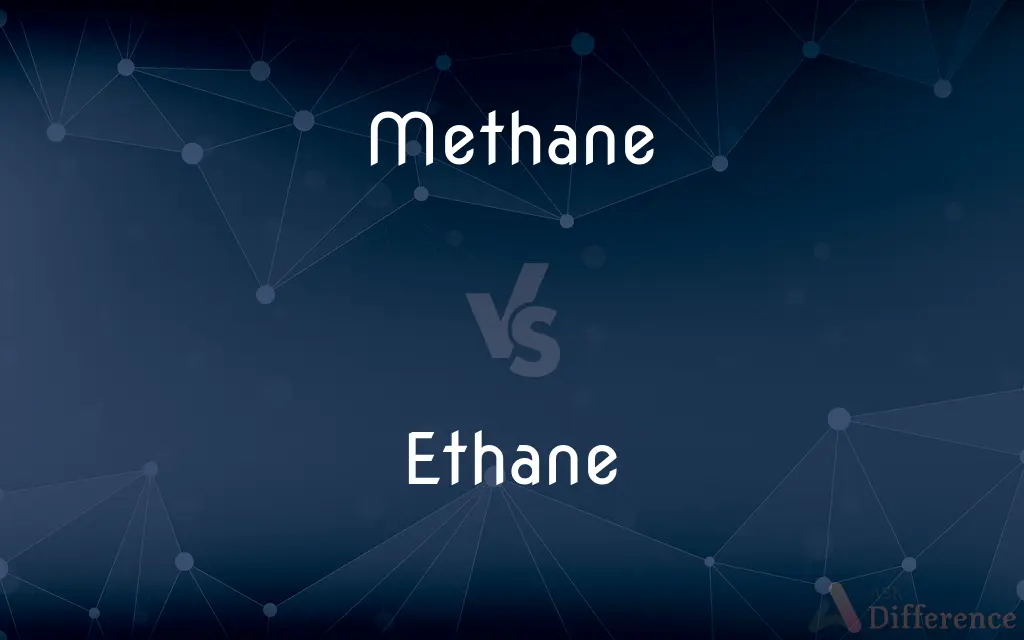Methane vs. Ethane — What's the Difference?
By Maham Liaqat & Urooj Arif — Updated on March 16, 2024
Methane is a simple hydrocarbon with one carbon atom, highly potent as a greenhouse gas, whereas ethane has two carbon atoms, less potent but significant in natural gas and petrochemical production.

Difference Between Methane and Ethane
Table of Contents
ADVERTISEMENT
Key Differences
Methane (CH4) is the simplest hydrocarbon, consisting of one carbon atom bonded to four hydrogen atoms. It is a primary component of natural gas and a potent greenhouse gas, contributing significantly to global warming. Ethane (C2H6), on the other hand, contains two carbon atoms and six hydrogen atoms, making it the second-simplest hydrocarbon. While less potent as a greenhouse gas compared to methane, ethane plays a crucial role in the petrochemical industry as a feedstock for ethylene production.
Methane is produced through both biological and geological processes, including decomposition in wetlands and as a byproduct of oil and gas extraction. Ethane, while also present in natural gas, is more commonly associated with the processing of natural gas and the cracking process in petrochemical industries.
In terms of environmental impact, methane has a global warming potential approximately 25 times greater than that of carbon dioxide over a 100-year period, making it a significant target for climate change mitigation efforts. Ethane's impact on global warming is less direct, but its extraction and use contribute to greenhouse gas emissions and can lead to increases in atmospheric methane when it escapes into the atmosphere unburned.
Methane's primary use is as a fuel source, where it is valued for its high energy content. It is used in electricity generation, heating, and as a fuel for vehicles in its compressed natural gas form. Ethane, while also combustible, is more valued for its role in producing ethylene, a precursor for plastics, resins, and other synthetic materials.
Monitoring and controlling emissions of both gases are crucial for environmental protection. Methane's leakage during extraction and distribution is a major concern, requiring stringent controls to minimize its climate impact. Ethane, while less focused on in climate discussions, still poses challenges due to its role in the petrochemical industry and potential for contributing to ozone formation.
ADVERTISEMENT
Comparison Chart
Composition
1 carbon atom, 4 hydrogen atoms
2 carbon atoms, 6 hydrogen atoms
Global Warming Potential
High, 25 times greater than CO2 over 100 years
Lower than methane, but contributes to GHG emissions
Production Source
Biological decomposition, oil and gas extraction
Natural gas processing, petrochemical industry
Primary Use
Fuel (heating, electricity, vehicles)
Petrochemical feedstock (ethylene production)
Environmental Impact
Significant greenhouse gas, targets for reduction
Less direct, but contributes to GHG emissions
Compare with Definitions
Methane
Simplest hydrocarbon, potent greenhouse gas.
Methane emissions from livestock significantly contribute to global warming.
Ethane
Found in natural gas.
Ethane is separated from natural gas and used as a feedstock for plastics.
Methane
Produced biologically and geologically.
Wetlands are natural sources of methane due to anaerobic decomposition.
Ethane
Second-simplest hydrocarbon, used in petrochemicals.
Ethane is cracked to produce ethylene, a key industrial chemical.
Methane
Primary component of natural gas.
Methane is extracted and processed for use as a clean energy source.
Ethane
Less potent as a greenhouse gas.
While not as impactful as methane, ethane emissions still contribute to global warming.
Methane
High energy content as fuel.
Methane is preferred for heating homes due to its high combustion efficiency.
Ethane
Essential for synthetic materials.
Ethane-derived products include plastics, antifreeze, and detergents.
Methane
Target for climate mitigation.
Reducing methane leakage from pipelines is crucial for climate goals.
Ethane
Role in energy and industry.
Ethane is a critical component in the production of energy and consumer goods.
Methane
Methane (US: , UK: ) is a chemical compound with the chemical formula CH4 (one atom of carbon and four atoms of hydrogen). It is a group-14 hydride and the simplest alkane and is the main constituent of natural gas.
Ethane
Ethane ( or ) is an organic chemical compound with chemical formula C2H6. At standard temperature and pressure, ethane is a colorless, odorless gas.
Methane
An odorless, colorless, flammable gas, CH4, the major constituent of natural gas, that is used as a fuel and is an important source of hydrogen and a wide variety of organic compounds.
Ethane
A colourless, odourless, flammable gas which is a constituent of petroleum and natural gas. It is the second member of the alkane series.
Methane
The simplest aliphatic hydrocarbon, CH₄, being a constituent of natural gas, and one of the most abundant greenhouse gases.
Greenhouse gas
Cattle emit a large amount of methane.
Ethane
A colorless, odorless gaseous alkane, C2H6, that occurs as a constituent of natural gas and is used as a fuel and a refrigerant.
Methane
Any of very many derivatives of methane.
Ethane
An aliphatic hydrocarbon, C2H6, gaseous at normal temperatures and pressures, being a constituent of natural gas.
Methane
A light, colorless, gaseous, inflammable hydrocarbon, CH4; marsh gas. It is the simplest of the aliphatic hydrocarbons. See Marsh gas, under Gas.
Ethane
The same compound, subjected to modification by replacing one or more of the hydrogen atoms with other radicals.
Chlorinated ethanes; halogenated ethanes
Methane
A colorless odorless gas used as a fuel
Ethane
A gaseous hydrocarbon, C2H6, forming a constituent of ordinary illuminating gas. It is the second member of the paraffin series, and its most important derivatives are common alcohol (ethyl alcohol), acetaldehyde, ether, and acetic acid. Called also dimethyl.
Ethane
A colorless odorless alkane gas used as fuel
Common Curiosities
What are the primary uses of methane and ethane?
Methane is mainly used as fuel, while ethane is used as a feedstock for producing ethylene in the petrochemical industry.
How are methane and ethane produced?
Methane is produced through biological decomposition and oil and gas extraction, while ethane primarily comes from natural gas processing.
What makes ethane valuable in the petrochemical industry?
Its ability to be cracked into ethylene, a precursor for many synthetic materials, makes it valuable.
What is the main difference between methane and ethane?
Methane has one carbon atom, making it a more potent greenhouse gas, while ethane has two carbon atoms and is crucial in petrochemical production.
Can ethane impact the environment?
Yes, though less directly than methane, ethane's extraction and use contribute to greenhouse gas emissions and can increase atmospheric methane levels.
Why is methane more concerning for climate change?
Due to its high global warming potential, being 25 times greater than that of CO2 over a 100-year period.
What technologies are used to capture methane?
Technologies include gas capture systems at landfills, oil and gas sites, and methane recovery from animal agriculture.
Is ethane recovery important?
Yes, it's economically valuable and reduces emissions by capturing ethane that would otherwise contribute to greenhouse gas levels.
Are there any uses for methane beyond fuel?
Beyond fuel, methane's uses are limited due to its high potency as a greenhouse gas and efforts to reduce its atmospheric concentration.
How can methane emissions be reduced?
Through improved technology and practices in gas extraction and distribution, and by capturing emissions from waste management.
How do methane and ethane contribute to global warming?
Methane directly contributes with a high global warming potential, while ethane contributes through its role in petrochemical processes and potential leakage.
How do the properties of methane and ethane differ?
Methane is lighter and more potent as a greenhouse gas, whereas ethane has a higher molecular weight and is significant for chemical synthesis.
How does ethane contribute to air pollution?
When unburned ethane is released into the atmosphere, it can contribute to ozone formation, impacting air quality.
Why is controlling ethane emissions important?
Controlling emissions helps in reducing the overall greenhouse gas impact and in the efficient use of natural resources.
What is the environmental impact of methane leakage?
Methane leakage exacerbates global warming and can lead to significant loss of life and biodiversity.
Share Your Discovery

Previous Comparison
Adjacent vs. Near
Next Comparison
Viscosity vs. DensityAuthor Spotlight
Written by
Maham LiaqatCo-written by
Urooj ArifUrooj is a skilled content writer at Ask Difference, known for her exceptional ability to simplify complex topics into engaging and informative content. With a passion for research and a flair for clear, concise writing, she consistently delivers articles that resonate with our diverse audience.














































